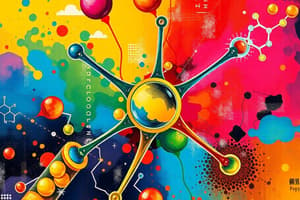Podcast
Questions and Answers
What is the primary function of triglycerides in the body?
What is the primary function of triglycerides in the body?
- Muscle repair
- Digestion of food
- Energy storage and insulation (correct)
- Hormone production
What role do phospholipids play in biological systems?
What role do phospholipids play in biological systems?
- Store genetic information
- Aid in protein synthesis
- Provide energy
- Form cell membranes (correct)
Which of the following statements about DNA is correct?
Which of the following statements about DNA is correct?
- Thymine pairs with Guanine.
- DNA is a single-stranded molecule.
- DNA is held together by hydrogen bonds. (correct)
- Uracil is present in DNA.
What distinguishes saturated fats from unsaturated fats?
What distinguishes saturated fats from unsaturated fats?
What is a nucleotide composed of?
What is a nucleotide composed of?
How many different proteins can be formed from a chain of 10 amino acids with 20 different types?
How many different proteins can be formed from a chain of 10 amino acids with 20 different types?
What is the key component of steroids in the cell membrane?
What is the key component of steroids in the cell membrane?
What type of bond holds complementary base pairs in DNA?
What type of bond holds complementary base pairs in DNA?
Which elements make up the majority of the human body's mass?
Which elements make up the majority of the human body's mass?
What characteristic of hydrogen contributes to hydrogen bonding?
What characteristic of hydrogen contributes to hydrogen bonding?
What does the pH scale range from, and what does each extreme represent?
What does the pH scale range from, and what does each extreme represent?
Which of the following statements about water's unique properties is true?
Which of the following statements about water's unique properties is true?
Which type of carbohydrate consists of long chains of sugar molecules?
Which type of carbohydrate consists of long chains of sugar molecules?
Which element is NOT a major component in the human body?
Which element is NOT a major component in the human body?
What happens to proteins when there are significant changes in pH levels?
What happens to proteins when there are significant changes in pH levels?
Which of the following statements correctly describes polar and non-polar molecules?
Which of the following statements correctly describes polar and non-polar molecules?
Which statement accurately describes atomic structure?
Which statement accurately describes atomic structure?
What determines the atomic number of an element?
What determines the atomic number of an element?
Which of the following statements about electrons is true?
Which of the following statements about electrons is true?
What is the result when an atom changes its number of protons?
What is the result when an atom changes its number of protons?
How are elements in the same column of the periodic table similar?
How are elements in the same column of the periodic table similar?
What is the primary factor driving atoms to bond?
What is the primary factor driving atoms to bond?
What is the difference between covalent and ionic bonding?
What is the difference between covalent and ionic bonding?
What does the term 'stable octet rule' refer to?
What does the term 'stable octet rule' refer to?
Flashcards
Atom
Atom
The smallest unit of an element that retains the chemical properties of that element.
Protons
Protons
Positively charged particles found in the nucleus of an atom.
Neutrons
Neutrons
Neutral particles found in the nucleus of an atom.
Electrons
Electrons
Signup and view all the flashcards
Atomic number
Atomic number
Signup and view all the flashcards
Atomic mass
Atomic mass
Signup and view all the flashcards
Valence shell
Valence shell
Signup and view all the flashcards
Octet rule
Octet rule
Signup and view all the flashcards
Major Elements in the Body
Major Elements in the Body
Signup and view all the flashcards
Polarity
Polarity
Signup and view all the flashcards
Hydrogen Bonding
Hydrogen Bonding
Signup and view all the flashcards
pH Scale
pH Scale
Signup and view all the flashcards
Inorganic Compound
Inorganic Compound
Signup and view all the flashcards
Organic Compound
Organic Compound
Signup and view all the flashcards
Monosaccharides
Monosaccharides
Signup and view all the flashcards
Polysaccharides
Polysaccharides
Signup and view all the flashcards
Macromolecule
Macromolecule
Signup and view all the flashcards
Glycogen
Glycogen
Signup and view all the flashcards
Triglycerides
Triglycerides
Signup and view all the flashcards
Saturated Fatty Acid
Saturated Fatty Acid
Signup and view all the flashcards
Unsaturated Fatty Acid
Unsaturated Fatty Acid
Signup and view all the flashcards
Phospholipid
Phospholipid
Signup and view all the flashcards
DNA (Deoxyribonucleic Acid)
DNA (Deoxyribonucleic Acid)
Signup and view all the flashcards
RNA (Ribonucleic Acid)
RNA (Ribonucleic Acid)
Signup and view all the flashcards
Study Notes
Matter and Atomic Structure
- Matter has mass and occupies space. Atoms make up matter.
- There are 92 naturally occurring elements.
- Atoms are mostly empty space.
- Atoms are composed of protons, neutrons, and electrons.
- Protons and neutrons are in the nucleus. They have a positive charge and neutrons have no charge.
- Electrons orbit the nucleus and have a negative charge.
- The number of protons equals the number of electrons.
- Atomic number is the number of protons.
- Atomic mass is the number of protons plus the number of neutrons.
- Electrons fill electron shells.
Composition of Matter
- Number of protons = number of electrons
- Atomic number = number of protons
- Atomic mass = weight of atom = protons + neutrons
- Atoms strive to be stable with full electron shells. Stability often involves bonding with other atoms.
Chemical Bonding
- Atoms bond to become stable.
- Valence electrons are involved in bonding.
- Covalent bonds involve sharing electrons.
- Ionic bonds involve transferring electrons.
Chemicals in the Body
- Human body is composed mainly of carbon, hydrogen, oxygen, and nitrogen (96%).
- Other elements (iron, calcium, etc.) make up the remaining 4%
- Carbon forms the foundation of many body structures due to its ability to form multiple bonds.
- Key is filling up the valence shell.
Attractions Between Molecules
- Opposite charges attract, like charges repel.
- Polar molecules have uneven distribution of charge, creating regions of positive and negative charge.
- Polarity causes some molecules to remain attracted to each other.
- Nonpolar molecules have an equal distribution of charges.
Hydrogen Bonding
- A special kind of attractive force in polar molecules
- Occurs between hydrogen and oxygen, nitrogen, or fluorine in neighboring molecules.
pH Scale
- Measures acidity or alkalinity of a substance.
- Ranges from 0 to 14, with 7 being neutral.
- Acids have a pH less than 7.
- Bases have a pH greater than 7.
Organic vs Inorganic
- Inorganic compounds do not contain carbon.
- Organic compounds typically contain carbon and hydrogen.
- Many of the chemicals in the body are organic.
Carbohydrates
- Monosaccharides are simple sugars (single sugars).
- Disaccharides are double sugars (two simple sugars).
- Polysaccharides are complex carbohydrates (multiple sugars).
- Key examples include starch, glycogen, and cellulose.
Lipids
- Triglycerides are energy storage molecules.
- Phospholipids are important in cell membranes.
- Steroids have diverse functions, including hormone production.
- Waxes provide protection and structure.
Nucleic Acids
- DNA and RNA carry genetic information.
- DNA uses the bases adenine, thymine, guanine, and cytosine.
- RNA uses adenine, uracil, guanine, and cytosine.
Proteins
- Polymers composed of amino acids.
- The specific sequence of amino acids determines a protein's 3-dimensional structure and function.
- The folding of proteins is crucial to their function.
Studying That Suits You
Use AI to generate personalized quizzes and flashcards to suit your learning preferences.




